- California Assembly OKs highest minimum wage in nation
- S. Korea unveils first graphic cigarette warnings
- US joins with South Korea, Japan in bid to deter North Korea
- LPGA golfer Chun In-gee finally back in action
- S. Korea won’t be top seed in final World Cup qualification round
- US men’s soccer misses 2nd straight Olympics
- US back on track in qualifying with 4-0 win over Guatemala
- High-intensity workout injuries spawn cottage industry
- CDC expands range of Zika mosquitoes into parts of Northeast
- Who knew? ‘The Walking Dead’ is helping families connect
International students take special Dokdo trip
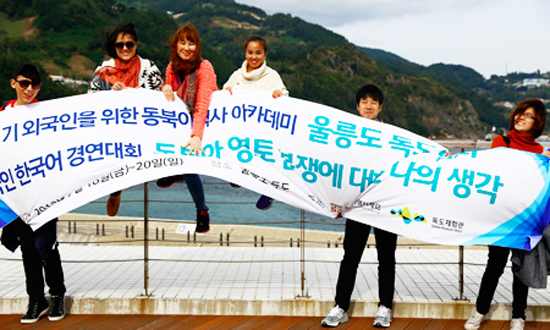
Foreign students from Mongolia, Ecuador, China and Singapore hold up a banner at Sadong Port on Ulleung Island, North Gyeongsang Province, Saturday, before embarking on a boat bound for Dokdo. The state-run Northeast Asian History Foundation arranged the field trip as part of its Northeast Asian history lectures for foreign students.
(Korea Times photo by Yoon Sung-won)
By Yoon Sung-won
A three-hour journey from Ulleung Island, North Gyeongsang Province, to Korea’s easternmost islets of Dokdo on Saturday was far from comfortable. As the boat rolled from side to side, pushing through the wild sea, passengers suffered from seasickness and some staggered toward the restroom because of nausea.
But as the boat arrived at the islets, they sprang back to life and started to savor the moment, taking photos, laughing, and holding the taegeukki, Korea’s national flag.
The scene was enough for foreigners to share with Koreans their love for Dokdo.
“My strongest impression of Dokdo was the amicable atmosphere like home, and the happy faces of both visitors and guards. I imagined it would be more solemn and grave like at the demilitarized zone,” Koh Tse-min, a Singaporean who visited Dokdo with other foreign students, said. “Looking at the Koreans’ faces overflowing with joy, I could feel their patriotic spirit even though I’m not Korean.”
The Northeast Asian History Foundation (NAHF), a state-run Dokdo research institute in Seoul, provided foreign students an uncommon experience of visiting the Dokdo islets.
The visit was part of a field trip between Oct. 18 and 21, a week before the Oct. 25 “Dokdo Day,” to the East Sea region including Ulleung Island. The day was designated by a Korean civic group to commemorate Emperor Gojong’s announcement in 1900 that the Dokdo Islets belonged to Ulleung Island and thus were Korean territory. A bill to mark the day as a national holiday has been pending in the National Assembly since 2008.
The field trip was organized as part of the NAHF academic program to promote foreigners’ understanding of the history of Northeast Asia. Students from Mongolia, China, Singapore, Japan and Ecuador participated in the trip.
“The academic program and this field trip is the first government-supported program that aims to give foreign students an opportunity to think about the ongoing territorial disputes in Northeast Asia by visiting Dokdo,” said Director of the Dokdo Museum in Seoul Chung Young-mi, who led the students during the trip. “I hope this trip can breed peaceful solutions to disputes over territorial sovereignty in the region in the future.”
During the decades-long territorial dispute between Seoul and Tokyo over Dokdo, public attention has continued to increase. According to North Gyeongsang provincial government, which oversees Dokdo, over 200,000 tourists took boats to the islets as of 2012.
Besides landing on Dokdo, the foreign students looked around Ulleung Island’s landscape and paid a visit to the Dokdo Museum in Ulleung.
On the first night of the field trip, a Korean speech contest for the students was held to commemorate the first anniversary of the Dokdo Museum in Seoul.
Sambuu Bulgantamir, a Mongolian student who was the third speaker that day, suggested his own view as a foreigner about how Korea and Japan should approach the territorial issue.
“The territorial dispute between the two countries has mainly focused on resources development and profitability. The two, including even Korea, were not interested enough in the islets before they realized Dokdo’s economic value,” he said. “I’d like to suggest designating the islets as a symbol of peace between Seoul and Tokyo, putting aside the long enmity. In that way, I believe the two can promote peace in Northeast Asia and protect the beautiful nature of the islets and the East Sea at the same time.”







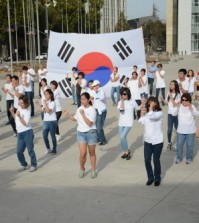
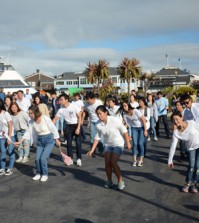
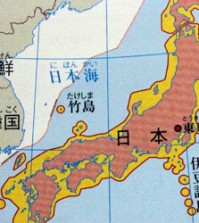
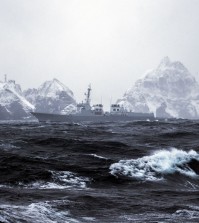

![일본 사도광산 [서경덕 교수 제공. 재판매 및 DB 금지]](http://www.koreatimesus.com/wp-content/uploads/2024/07/PYH2024072610800050400_P4-copy-120x134.jpg)


